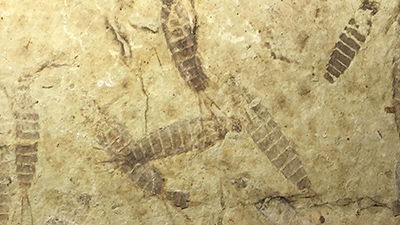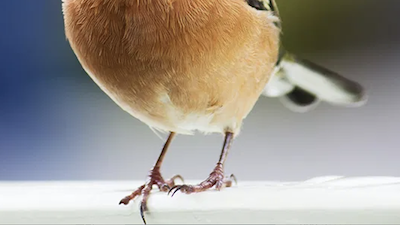Common Ancestor Hidden in Burgess Shale
Burgess Shale said to shelter “the most primitive known vertebrate and therefore the ancestor of all descendant vertebrates, including humans.”
News Source
- University of Cambridge: “Human’s Oldest Ancestor Found”
A tiny worm fossil found in the Burgess Shale formation of the Canadian Rockies is now confirmed, according to a study just published in Biological Reviews, as the oldest common ancestor of all vertebrates, including birds, reptiles, fish, and humans. The Pikaia gracilens, a worm discovered in 1911 in a fossil graveyard near Field, British Columbia, despite the caption quoted above, is not itself a vertebrate, but it may be a chordate. Evolutionary scientists have cast it in the role of vertebrate ancestor because it seems to have a notochord and myomeres.
“I look at myself in the mirror, and I can recognize the elongated body with all these muscle bands, and it's an animal that was certainly very agile,” says Dr. Jean-Bernard Caron, curator of Invertebrate Palaeontology at the Royal Ontario Museum. “Pikaia is something that people can take close to heart, because we are connected.”1
Caron and Cambridge professor Simon Conway Morris examined worm fossils from this famous Middle Cambrian formation, dated at 505 million years, with a scanning electron microscope. When first discovered, Pikaia was thought “to have a very primitive notochord—a flexible rod found in the embryos of all chordates—which,” according to the Cambridge Research News, “goes on to make up part of the backbone in vertebrates.” The researchers report the structure originally thought to be a notochord was not a notochord at all.2 However, another “strand of tissue is interpreted as representing the nerve chord and notochord.”3
Although they write this notochord identification is “tentative,”4 they express more certainty about the presence of myomeres—“a series of segmented muscle blocks.”5
“Our analysis provides evidence that Pikaia indeed had a notochord,” said Caron. “But the real excitement was finding extensive myomeres, the blocks of skeletal muscle tissue that are characteristic of chordates.”
The discovery of myomeres is the smoking gun that we have long been seeking.
“The discovery of myomeres is the smoking gun that we have long been seeking,” said Morris. “Now with myomeres, a nerve chord, a notochord and a vascular system all identified, this study clearly places Pikaia as the planet’s most primitive chordate. So, next time we put the family photograph on the mantle-piece, there in the background will be Pikaia.”
The word notochord refers to a rod-like structure supporting the central nerve cord of some rare living creatures like lancelets—an eel-like marine worm—and also to a similar structure in vertebrate embryos. Myomeres are blocks of skeletal muscle reflecting the segmental organization typically found in chordates. (A chordate is an organism that has a notochord and a central nerve cord for at least part of its life.) The word myomere—as a synonym for myotome—also refers to the part of an embryonic somite destined to develop into skeletal muscle. Somites are blocks of embryonic tissue genetically programmed to develop into specific tissues (such as muscle, skin, and bone) and to direct the organization of other nearby structures such as nerves. Muscles formed from each myotome are innervated by nerves embryologically associated.
Contrary to popular belief (and to the impression given in the article cited here), the notochord in vertebrates, the alleged descendants of the Pikaia, does not develop into the vertebrate spinal column. Instead, the vertebrate embryo’s notochord supports and guides the formation of adjacent structures such as the neural tube (future spinal cord) and the vertebral column. The embryonic notochord, like many embryonic structures, virtually disappears after it completes the job of organizing the developing anatomy, persisting only as a portion of the intervertebral disks. (In fact, if the cells of embryonic notochord do not disappear from the vertebral bones themselves, they can cause problems.)
Evolutionists maintain vertebrates evolved from “simpler” forms. Some rare creatures have a notochord but no actual vertebrae. Therefore, evolutionists believe the presence of a notochord and other structures resembling vertebrate embryonic anatomy is evidence vertebrates evolved from a common ancestor possessing a notochord. This belief is thought by some to be supported by the discredited “theory” of embryonic recapitulation—the idea that the anatomy of developing embryos retraces their evolutionary history.6 Many evolutionists today embrace a twist on this idea since the discovery of genes that switch other groups of genes on and off. They believe switching genes on and off supplies sufficient raw material for new kinds of organisms to evolve. At any rate, in the search for a vertebrate ancestor, many evolutionists grasp at a creature with a notochord and segmentally arranged muscle units, identifying a simpler creature that seems to follow the vertebrate embryonic pattern as a primitive ancestor.
Modern information about genetic switches also fails to supply the information for more complex organisms to evolve or to explain the source of the information in the first place.
Based on the latest research, the Pikaia apparently is a chordate. Vertebrates are a subset of chordates, but only imagination “connects the dots” by insisting vertebrates evolved from invertebrate ancestors through ancestral forms possessing notochords. Embryonic recapitulation theory was originally an attempt to prove this idea. Modern information about genetic switches also fails to supply the information for more complex organisms to evolve or to explain the source of the information in the first place.
Furthermore, though hailed as the most primitive known ancestor of all vertebrates, Pikaia is found in rock layers above fossils of fish-like fossil chordates with rudimentary vertebrae and more developed cranial and visual structures than either Pikaia or living lancelets possess. These Haikouichthys fossils were found in Early Cambrian rocks in China.7 Thus Pikaia cannot be the ancestor of vertebrates based on evolutionary thinking because more advanced organisms appear beneath it in the fossil record.
Embryonic homologues to structures in adult organisms do not prove evolutionary ancestry. They are merely examples of similar designs in development, evidence of a Common Designer. Burgess Shale formations around the world preserve soft-bodied organisms found nowhere else. Thus if any true transitional forms existed, they would have their best chance of preservation in that layer. Pikaia is an interesting chordate, but nothing about it proves it either ancestral or transitional to vertebrates. Its “myomeres” aren’t a “smoking gun” identifying it as a vertebrate ancestor, just a “smoking gun” identifying it as a probable chordate. And organisms more “advanced” appear even in deeper layers of the Cambrian “explosion.” God created all kinds of organisms in the first week of Creation about 6,000 years ago, and many of their descendants were eventually preserved as fossils in the global Flood.
Actually, the delicate creatures found in Burgess Shale are typically preserved at a variety of angles to the rock bedding as would be expected by rapid burial in a catastrophic landslide of a muddy sea bottom.8 These findings are consistent with rapid burial in the global Flood as described in Genesis.
Further Reading
For More Information: Get Answers
Remember, if you see a news story that might merit some attention, let us know about it! (Note: if the story originates from the Associated Press, FOX News, MSNBC, the New York Times, or another major national media outlet, we will most likely have already heard about it.) And thanks to all of our readers who have submitted great news tips to us. If you didn’t catch all the latest News to Know, why not take a look to see what you’ve missed?
(Please note that links will take you directly to the source. Answers in Genesis is not responsible for content on the websites to which we refer. For more information, please see our Privacy Policy.)
Footnotes
- Michael Platt, “Worm Is Our Long-lost Relative, Say Researchers,” Calgary Sun, March 5, 2012, http://www.calgarysun.com/2012/03/05/worm-is-our-long-lost-relative-say-researchers.
- Simon Conway Morris and Jean-Bernard Caron, “Pikaia gracilens Walcott, a Stem-group Chordate from the Middle Cambrian of British Columbia,” Biological Reviews, March 4, 2012, doi: 10.1111/j.1469-185X.2012.00220.x.
- Ibid.
- Ibid.
- John von Radowitz, “Humans ‘Evolved from Worm Creature’,” 9 News, March 6, 2012, http://news.ninemsn.com.au/technology/8430360/humans-evolved-from-worm-creature.
- The idea of embryonic recapitulation gained many adherents as a result of zoologist Ernst Haekel’s fraudulent artwork. Although Haekel’s work—published in 1868—was refuted by reputable German scientists almost as soon as it was published, it has continued to be used as evidence for embryonic recapitulation ever since. Textbooks throughout the 20th century continued to feature this “proof of evolution,” using it to illustrate the prevailing evolutionary view. Evolutionary scientists closed out the 20th century by refuting embryonic recapitulation in a 1997 study called “There is no highly conserved embryonic stage in the vertebrates: implications for current theories of evolution and development.” (Richardson, M. et al. 1997. There is no highly conserved embryonic stage in the vertebrates: implications for current theories of evolution and development. Anat Embryol 196:91-106.) We featured an article showing a typical resurrection of this outmoded idea in the media as recently as May 18, 2011.
- “Vetebrates: Fossil Record,” University of California Museum of Paleontology, http://www.ucmp.berkeley.edu/vertebrates/vertfr.html.
- R. Cowen, History of Life (Boston: Blackwell Scientific Publications, 1990), 90; and Briggs and Collier, The Fossils of the Burgess Shale (Washington and London: Smithsonian Institution Press, 1994), 27.
Recommended Resources

Answers in Genesis is an apologetics ministry, dedicated to helping Christians defend their faith and proclaim the good news of Jesus Christ.
- Customer Service 800.778.3390
- Available Monday–Friday | 9 AM–5 PM ET
- © 2025 Answers in Genesis






